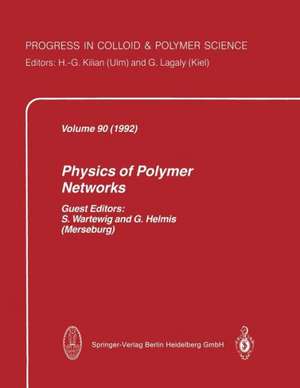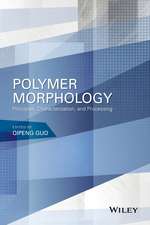Physics of Polymer Networks: Progress in Colloid and Polymer Science, cartea 90
S. Wartewig, G. Helmisen Limba Engleză Paperback – 19 noi 2013
Din seria Progress in Colloid and Polymer Science
- 24%
 Preț: 816.64 lei
Preț: 816.64 lei -
 Preț: 407.01 lei
Preț: 407.01 lei -
 Preț: 392.21 lei
Preț: 392.21 lei -
 Preț: 387.20 lei
Preț: 387.20 lei -
 Preț: 403.91 lei
Preț: 403.91 lei - 15%
 Preț: 643.00 lei
Preț: 643.00 lei - 15%
 Preț: 657.39 lei
Preț: 657.39 lei -
 Preț: 399.67 lei
Preț: 399.67 lei -
 Preț: 391.02 lei
Preț: 391.02 lei -
 Preț: 392.97 lei
Preț: 392.97 lei -
 Preț: 398.92 lei
Preț: 398.92 lei - 15%
 Preț: 651.67 lei
Preț: 651.67 lei -
 Preț: 391.40 lei
Preț: 391.40 lei - 24%
 Preț: 1061.33 lei
Preț: 1061.33 lei -
 Preț: 393.35 lei
Preț: 393.35 lei - 15%
 Preț: 637.93 lei
Preț: 637.93 lei -
 Preț: 409.13 lei
Preț: 409.13 lei -
 Preț: 386.99 lei
Preț: 386.99 lei -
 Preț: 393.35 lei
Preț: 393.35 lei -
 Preț: 400.47 lei
Preț: 400.47 lei -
 Preț: 387.38 lei
Preț: 387.38 lei - 15%
 Preț: 634.82 lei
Preț: 634.82 lei - 20%
 Preț: 564.51 lei
Preț: 564.51 lei - 24%
 Preț: 796.54 lei
Preț: 796.54 lei - 24%
 Preț: 818.94 lei
Preț: 818.94 lei - 18%
 Preț: 944.51 lei
Preț: 944.51 lei - 24%
 Preț: 1059.27 lei
Preț: 1059.27 lei - 24%
 Preț: 1049.38 lei
Preț: 1049.38 lei - 24%
 Preț: 793.89 lei
Preț: 793.89 lei - 18%
 Preț: 1222.17 lei
Preț: 1222.17 lei - 18%
 Preț: 946.41 lei
Preț: 946.41 lei - 18%
 Preț: 952.40 lei
Preț: 952.40 lei - 18%
 Preț: 1221.20 lei
Preț: 1221.20 lei - 24%
 Preț: 1050.74 lei
Preț: 1050.74 lei - 24%
 Preț: 798.62 lei
Preț: 798.62 lei - 24%
 Preț: 1046.72 lei
Preț: 1046.72 lei
Preț: 951.14 lei
Preț vechi: 1159.94 lei
-18% Nou
Puncte Express: 1427
Preț estimativ în valută:
181.100€ • 190.53$ • 150.59£
181.100€ • 190.53$ • 150.59£
Carte tipărită la comandă
Livrare economică 05-19 aprilie
Preluare comenzi: 021 569.72.76
Specificații
ISBN-13: 9783662156926
ISBN-10: 366215692X
Pagini: 260
Ilustrații: VIII, 249 p. 22 illus.
Dimensiuni: 210 x 279 x 14 mm
Greutate: 0.61 kg
Ediția:Softcover reprint of the original 1st ed. 1992
Editura: Steinkopff
Colecția Steinkopff
Seria Progress in Colloid and Polymer Science
Locul publicării:Heidelberg, Germany
ISBN-10: 366215692X
Pagini: 260
Ilustrații: VIII, 249 p. 22 illus.
Dimensiuni: 210 x 279 x 14 mm
Greutate: 0.61 kg
Ediția:Softcover reprint of the original 1st ed. 1992
Editura: Steinkopff
Colecția Steinkopff
Seria Progress in Colloid and Polymer Science
Locul publicării:Heidelberg, Germany
Public țintă
Professional/practitionerCuprins
Theory of phantom networks — topology, structure, elasticity: New and open problems.- Structural properties of randomly crosslinked polymer networks.- The dynamics of tire tread compounds and their relationship to wek skid behavior.- Relaxation in permanent networks.- Do local motions influence rheological properties near the gelation threshold?.- On the dynamics of moderately and lightly crosslinked polymer networks.- A new approach to polymer networks including finite chain extensibility, topological constraints, and constraints of overall orientation.- Formation of networks — a lattice model for kinetic growth processes.- Gelation and 1,1-transition in three-dimensional condensation and chain polymerization.- Effect of thermal history on amylose gelation.- Rheological, potentiometric and 23Na NMR studies on pectin-calcium systems.- The formation of semiinterpenetrating polymer networks by photoinduced polymerization.- Observation of the curing process of epoxy resins by inverse gas chromatography.- Fluorescence probe studies during the curing of epoxy systems.- Conditions of formation and equilibrium swelling of polymer networks formed by protein macromolecules.- Cross-link fluctuations: NMR properties and rubber elasticity.- Segmental orientation in filled networks.- Field-cycling NMR relation spectroscopy of molten linear and cross-linked polymers Observation of a T 1 ? ?0.25 law for semi-global chain fluctuations.- Segmental orientation of "long" and "short" chains in strained bimodal PDMS networks: A 2H-NMR study.- Small chains in a deformed network. A probe of heterogeneous deformation?.- Aggregation of free chains within a deformed network: A SANS study.- Trapped entanglements in polymer networks and their influence on the stress-strain behavior up tolarge extensions.- Physical and chemical network effects in polyurethane elastomers.- Influence of the thermodynamical quality of the solvent on the properties of polydimethylsiloxane networks in swollen and dry states.- Triblock copolymers, mesogels and deformation behavior in poor solvents.- Microemulsion mediated polymer networks.- Theory of the mechanical and swelling properties of elastomers with chemical and physical networks.- The effect of free branches on the collapse of olyelectrolyte networks.- Local order and statistics of a polymer chain in an external electric field.- Charge photogeneration in carbazole-containing compounds and valency bands of oligomers.- The peculiarities and nature of large-scale motion of highly crosslinked polymers.- FTIR spectroscopy studies on epoxy networks.- Influence of imidazole on the structure of epoxy amine networks.- Epoxy polymer networks: Relaxation processes and crack resistance.- Fluorescence study of interpenetrating network morphology of polymer films.- Kinetic regularities of polymer network thermal degradation.- Interpenetrating polymer networks based on EVA copolymer and PMMA.- Fast segmental dynamics in poly(methyl metharcrylate)-polyurethane interpenetrating networks.- Thermally and mechanically activated degradation of polyesterurethane networks. Analysis of molecular weight distribution functions.- The solidification of bulk and solution cast segmented polyurethanes.









